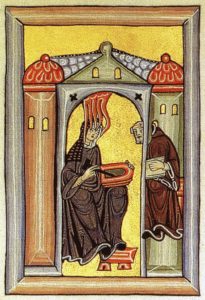Hildegard von Bingen, Caritas abundat

Hildegard von Bingen (c. 1098-1179) is one of the earliest composers we can identify by name. A saint, doctor of the church, mystic, and abbess, she experienced visions throughout her life. She eventually recorded her visions and left a significant body of writing on theology and natural science.
The image here is an illumination from her Liber Scivias showing Hildegard receiving a vision and dictating to her scribe.
Even if she had not become a hot topic of research in the past few decades, we would have needed to include her story in our Early Sacred Music course.
So we stopped by her abbey at Eibingen, now a part of Rüdesheim am Rhein, just across the Rhine from Bingen. There we filmed a short commentary while trying to keep a couple of motorcycles out of the shot.
But nothing really captures Hildegard as well as the performance we filmed in a 15th-century church outside Milan. For three days, we filmed numerous performances of medieval and Renaissance music with the Ring Around Quartet. They even brought along several of their colleagues with harps, drums, viol da gambas, and a portativ organ. Before we get to the performance, take a look at the setting.
Caritas abundat gives you an example of one of the earliest forms of polyphony—a single-line melody over a drone. In this performance, the three singers in the background create the drone.
The Latin text is as follows:
Caritas abundat in omnia,
de imis excellentissima
super sidera,
atque amantissima in omnia,
quia summo Regi
osculum pacis dedit.
Love abounds in all, from the depths exalted and excelling over every star, and most beloved of all, for to the highest King the kiss of peace she gave.
RingAround Caritas from Professor Carol on Vimeo.



